I am trying to approximate a function (the right hand side of a differential equation) of the form ddx=F(x,dx,u) (where x,dx,u are scalars and u is constant) with an RBF neural network. I have the function F as a black box (I can feed it with initial x,dx and u and take x and dx for a timespan I want) and during training (using sigma-modification) I am getting the following response plotting the real dx vs the approximated dx.
Then I save the parameters of the NN (the centers and the stds of the gaussians, and the final weights) and perform a simulation using the same initial x,dx and u as before and keeping, of course, the weights stable this time. But I get the following plot.
Is that logical? Am I missing something?
The training code is as follows:
%load the results I got from the real function
load sim_data t p pd dp %p is x,dp is dx and pd is u
real_states = [p,dp];
%down and upper limits of the variables
p_dl = 0;
p_ul = 2;
v_dl = -1;
v_ul = 4;
pd_dl = 0;%pd is constant each time,but the function should work for different pds
pd_ul = 2;
%number of gaussians
nc = 15;
x = p_dl:(p_ul-p_dl)/(nc-1):p_ul;
dx = v_dl:(v_ul-v_dl)/(nc-1):v_ul;
pdx = pd_dl:(pd_ul-pd_dl)/(nc-1):pd_ul;
%centers of gaussians
Cx = combvec(x,dx,pdx);
%stds of the gaussians
B = ones(1,3)./[2.5*(p_ul-p_dl)/(nc-1),2.5*(v_ul-v_dl)/(nc-1),2.5*(pd_ul-pd_dl)/(nc-1)];
nw = size(Cx,2);
wdx = zeros(nw,1);
state = real_states(1,[1,4]);%there are also y,dy,dz and z in real_states (ignored here)
states = zeros(length(t),2);
timestep = 0.005;
for step=1:length(t)
states(step,:) = state;
%compute the values of the sigmoids
Sx = exp(-1/2 * sum(((([real_states(step,1);real_states(step,4);pd(1)]*ones(1,nw))'-Cx').*(ones(nw,1)*B)).^2,2));
ddx = -530*state(2) + wdx'*Sx;
edx = state(2) - real_states(step,4);
dwdx = -1200*edx * Sx - 4 * wdx;
wdx = wdx + dwdx*timestep;
state = [state(1)+state(2)*timestep,state(2)+ddx*timestep];
end
save weights wdx Cx B
figure
plot(t,[dp(:,1),states(:,2)])
legend('x_d_o_t','x_d_o_t_h_a_t')
The code used to verify the approximation is the following:
load sim_data t p pd dp
real_states = [p,dp];
load weights wdx Cx B
nw = size(Cx,2);
state = real_states(1,[1,4]);
states = zeros(length(t),2);
timestep = 0.005;
for step=1:length(t)
states(step,:) = state;
Sx = exp(-1/2 * sum(((([real_states(step,1);real_states(step,4);pd(1)]*ones(1,nw))'-Cx').*(ones(nw,1)*B)).^2,2));
ddx = -530*state(2) + wdx'*Sx;
state = [state(1)+state(2)*timestep,state(2)+ddx*timestep];
end
figure
plot(t,[dp(:,1),states(:,2)])
legend('x_d_o_t','x_d_o_t_h_a_t')